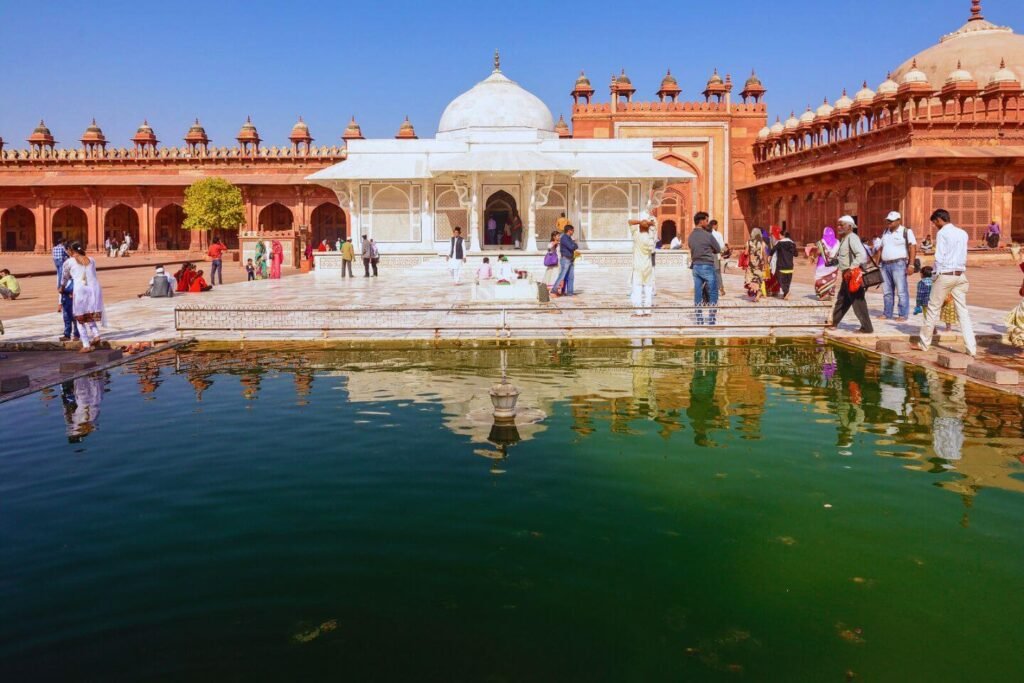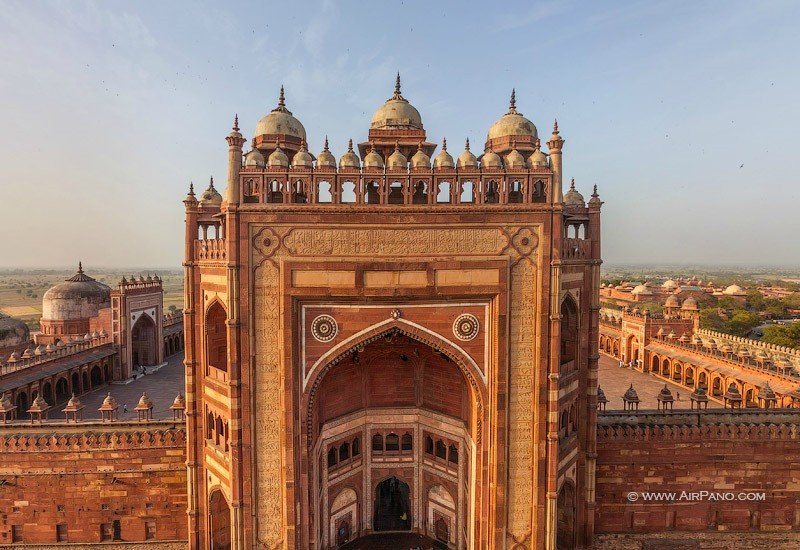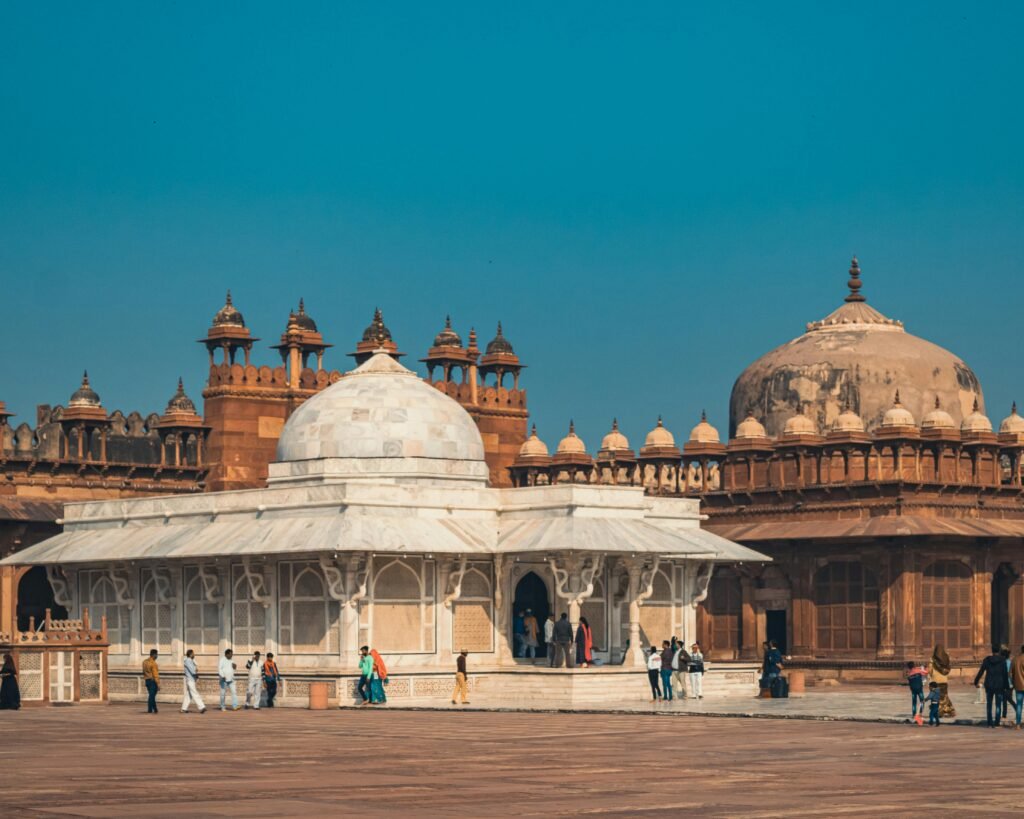atehpur Sikri is a UNESCO World Heritage Site which has the rich cultural heritage of India. This place is known for the Dargah of Salim Chishti, who blessed Akbar for a son. People from all religions come here to the Dargah with wishes that include having a child. This is a prominent Sufism place on the world map. Sufism is based on humanity. Travelers find a touch of Sufism as well as pottery of architecture in the complex. They enjoy Qawwali (कव्वाली) here. It is a wonderful example of Indo-Islamic architecture destination for history buffs, photographers and architecture lovers. Three more world heritage sites are hardly 40 Kms away from here.
Tale of Fathepur Sirki
Emperor Akbar prayed for a child here. With the saint’s Salim Chishti blessings, Akbar was blessed with a son, Salim. The Dargah of Salim Chishti, located within the historic Fatehpur Sikri complex, is one of the most iconic Sufi shrines in India. Salim Chishti was a revered saint of the Chishti order, known for his spirituality and humanity. The devotees of every religion come to the Dargah with the wish of having a child.
Historical Importance
Sikri, “The City of Victory” was an important halt for merchants on the routes across the northern India. Fatehpur Sikri was the Mughal capital under the rule of the Emperor Akbar (1556-1605).
Sufism in India
India van guarded the Islamic Sufism movement. Notable figures such as Moinuddin Chisti, Nizamuddin Auliya, Amir Khusrau etc. played pivotal roles in India’s Sufism.
Why Visit?
Three more world heritage sites: the Taj Mahal (approximately 40 Kms), the Agra fort (approximately 40 Kms), and the Keoladeo National Park/Bharatpur bird century (approximately 25 Kms) are at close distance. And the bird century to The Taj Mahal distance is approximately 65 Kms. It is a triangle of three world heritage sites.
Best Time to Visit:

You may enjoy different colors of weather here.
October – March (winter): Ideal time to visit; pleasant weather for sightseeing and walking.
April – June (summer): Hot afternoons, but early morning or late evening most people comes.
July – September (monsoon): Natural beauty is at its best
Tourist attractions:
Buland Darwaza
This gate can be approached from the outside by a 13-metre flight of steps which adds to its grandeur. The gate erected in 1602 AD to commemorate Akbar’s victory over Deccan is the highest and grandest gateway in India and ranks among the biggest in the world.

Diwan-I-Am
The journey to the royal palace begins with Diwan-I-Am or the Hall Of Public Audience. It has cloisters on three sides of a rectangular courtyard. To the west is a pavilion with the Emperor’s throne. Beautiful jali screen on either side separated the ladies attending the court.
Diwan-khana-I-khaas
To the right is an apparently looking two storey building known as diwan-khana-I-khaas or Hall Of Private Audience. On entering it, one finds only a single vaulted chamber. In the centre stands a profusely carved column supporting a collosal-bracketed capital. Four narrow causeways project from the centre and run to each corner of the chamber.
Turkish Sultana’s House
To the left of the Pachisi Board is the Turkish Sultana’s house. The house, as its location at the corner of Anup Talao shows, was a pavilion for repose, attached to the pool. The geometrical pattern on the ceiling is reminiscent of Central Asian carvings in wood.
The Treasury
To the left of the Diwan-I-Khaas is the Treasury or Ankh Michauli.
Daulat khana-I-khas
Located in the corner to the left is the emperor’s private chamber. It has two main rooms on the ground floor. One housed Akbar’s library while the larger room was his resting area. On the first floor is the Khwabgah or the bed-chamber.
Palace of Jodha Bai
To the left of the Sunehra Makan is the largest and the most important building in the royal palace, named after Akbar’s Rajput wife, Jodha Bai. The architecture is a blend of styles with Hindu columns and Muslim cupolas.
Hawa Mahal And Nagina Masjid
To the right of Jodha Bai’s palace is Hawa Mahal, the Palace of Winds.
.
The Jami Masjid
One of the largest mosques in India, Jami Masjid was built in 1571 AD. Inside, there is a vast congregational courtyard. To the right, at the corner, is the Jammat Khana Hall and next ot this is the tomb of the royal ladies. To the left of the Jami Masjid is the Stone Cutters’ mosque, the oldest place of worship at Fateh Pur Sikri. It is entered through the eastern entrance known as the Buland Darwaza.
How to Reach
This place is well-connected and easy to reach from major cities like Agra and Delhi.
By Air:
- The nearest Airport: Agra Airport (40 km)
- Delhi IGI Airport (230 km) – Well-connected to all major cities
By Train:
- The nearest Station: Fatehpur Sikri Railway Station (1.5 km)
- Alternatively, take a train to Agra Cantt and hire a taxi or bus
By Road:
- From Agra: 1.5-hour drive via NH-21
- From Delhi: 4-hour drive (230 km) via Yamuna Expressway
- Regular buses and shared cabs available from Agra and Bharatpur
Best Places to Stay
The town has many hotels and inn.
Nearby Attractions
These nearby gems:
• Agra (40 km): Taj Mahal, Agra Fort, and Mehtab Bagh
• Bharatpur (25 km): Known for the Keoladeo National Park, a UNESCO wildlife sanctuary
• Mathura & Vrindavan (90 km): Sacred cities related to Lord Krishna
• Chambal River Safari (75 km): Spot gharials, dolphins, and rare birds in the wiTravel Tips:
✔ Wear comfortable footwear – There’s a lot of walking involved
✔ Hire a local guide to get deeper historical insights
✔ Entry fee – keep cash/card handy
✔ Carry water, sunscreen, and a hat, especially in summer
✔ Be respectful in religious places.
✔ Try local snacks and souvenirs near the entrance
Main news of 2025
Urs : Annual function
- 17th ‘Sajjada Nashin : Peerzada Arshad Faridi on 7th, April 2025 officially took charge as the 17th ‘Sajjada Nashin’ of the Sheikh Salim Chishti Dargah in Fatehpur Sikri after ‘Dastarbandi’ (ceremony of tying turban), a ritual signifying the transfer of spiritual leadership, marking the first such ceremony in 80 years.
- Arshad Faridi replaced his father Raees Miyan to become the 17th generation member from his family to take charge of the Salim Chishti Dargah. The last time the Dastarbandi ceremony was conducted was in 1945, when Raees Miyan was appointed Sajjada Nashin at the age of seven, people associated with the management of the Dargah said.
Writer: Hitendra Srivastava
